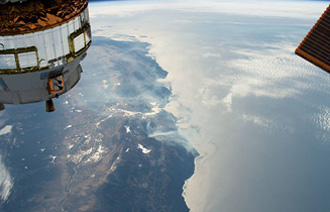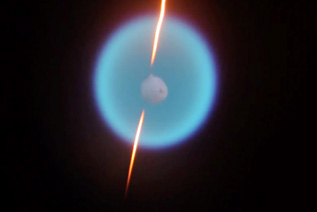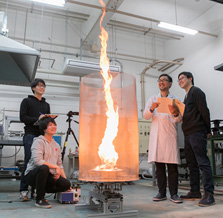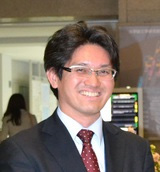
ここからコンテンツです。

Firefighting in challenging conditions
How do you tackle a blaze on a space station?Yuji Nakamura

Professor Yuji Nakamura specializes in combustion science and focuses on fire and firefighting in special environments such as spacecraft and forests. Prof. Nakamura uses scale model experiments to investigate phenomena in environments that are difficult to reproduce. However, the environment and scale of these models are far removed from the actual situations. This being the case, the key to reproducing the same phenomenon is to follow "similarity rules" which act as the conditions for such experiments. In addition to his research based on this unusual approach, Prof. Nakamura is also attracting attention for his development of the unique "vacuum extinction method" that is useful for extinguishing fires in special environments such as the space station. We spoke with Prof. Nakamura about his original approach and his thoughts on university education.
Interview and report by Madoka Tainaka
Stopping forest fires can make a big contribution to reducing CO2 emissions
At present, the mainstream of combustion science is concerned with the "use of combustion," such as how to burn fuel efficiently to extract energy. This can be seen in efforts to reduce fuel consumption in automobile engines, for example. However, Prof. Nakamura is focused on "combustion suppression" in the field of combustion science. Why does he focus on researching phenomena that are so difficult to reproduce, such as fires in special environments such as on a space station?

"Research on the use of combustion is of course an important topic, but researchers have worked to improve combustion efficiency for many years, so these days it is difficult to increase efficiency by even 1%. So, focusing on this is not very effective. On the other hand, the damage caused by forest fires, for example, is enormous. It varies from year to year, but the amount of CO2 emitted due to forest fires is said to account for about 10% of the world's CO2 emissions. In other words, if we can stop the spread of even one forest fire, it would be more effective than creating more efficient combustion technology.
As well as its role in reducing CO2, preventing fires is also essential for creating a safe and secure society. Fires are not limited to general buildings, but occur also in facilities such as spacecraft, submarines, or nuclear power plants, where they can cause significant damage. Of course, such facilities are fully equipped with fire protection measures, but the risk is not zero. Suppressing any fires that do occur can have a great impact on society," says Prof. Nakamura, describing the significance of his research.
A significant challenge is that the results of fire research differ greatly depending on the environment and conditions, but the conditions considered by Prof. Nakamura's work are impossible to reproduce exactly in the laboratory. Furthermore, any research that cannot be reproduced runs the risk of being considered unscientific. In fact, when Prof. Nakamura told his academic advisor that he wanted to do basic research on fires in space as the topic for his Ph.D., he was advised against it because it was not an academic topic.
"I thought, if my academic advisor, who is an authority on basic combustion science, cannot do it, I bet no one can do it. So I decided to do it! (laughs) If I was going to do something, I wanted to do something that nobody else was doing."
This sentiment captures the pioneering spirit of Prof. Nakamura, which has remained unchanged since his student days.
"Similarity rules" that help reproduce phenomena at different scales
Prof. Nakamura introduced an experimental method based on models in order to study difficult-to-reproduce fires in space. Simply put, he uses a model to try to reproduce the same conditions as space without actually going to space.
"One of the biggest problems I encountered when researching fires on space stations as a research topic was that I couldn't simulate zero gravity. Dropping a capsule to create weightlessness allows you to conduct an experiment for a few seconds and costs millions of yen each time. So that is far too expensive. Flames become round in zero gravity, but despite a great deal of thinking about the problem, I couldn't find a way to make a round flame. Just around that time, I encountered a phenomenon while studying abroad in the United States in which the shape of a flame becomes round as you make it smaller. It came as a great shock when I found out that just reducing the flame size could create a situation that would be less susceptible to buoyancy," says Prof. Nakamura.
Just by changing the size of the flame, it is possible to reproduce zero gravity flames. Thinking about why this is the case, he discovered that he just needed to satisfy certain laws.

"Those are the similarity rules. If you follow the similarity rules, you can predict that if you reduce the air pressure, you can approach weightlessness. So, when I burned a flame in a partial vacuum, it really did become round. In other words, you can reproduce the same phenomenon as you would find in zero gravity if you make the flame small or reduce the surrounding air pressure and weaken the relative buoyancy. In this way, I was convinced that I could study fires in space even on earth by conducting appropriate scale model experiments."
Actually, this principle is exactly the same as the trick used to make special effects look realistic in movies. For example, in scenes of the movie "Godzilla" that include special effects, a miniature Godzilla of about 1:25 scale is used, and in scenes where Godzilla smashes or drops things, the film is shot at 4 to 5 times faster than normal speed and then reproduced in slow motion. By showing the film at a slower speed than the actual movement, you can represent movement at a different scale. Prof. Nakamura explains that the mathematical expressions for this are known as "similarity rules."
"Taking Godzilla as an example, if we assume that we must satisfy the simplest ‘similarity rule,' we can easily calculate that we should shoot at 5x normal speed. Professional special effects engineers know from experience that this speed is suitable for making the movement look realistic."
Similarity rules are convenient, but it is not easy to derive them. Of course, there are many established similarity rules, and they are used in various situations such as vibration experiments for models of bridges. However, similarity rules have not been determined for all physical phenomena in the world, and similarity rules for combustion in space cannot be found in any book.
"In the case of combustion, it is particularly difficult to derive similarity rules because there are many factors that affect the phenomenon such as heat, airflow, and reactions. I thought that if I could find a way to easily derive similarity rules for specific situations, it would be of great help when solving various problems that people had given up on. It would mean that we would be able to use a laboratory to reproduce fires that occur in certain special environments, such as space, or even large-scale wildfires."
A vacuum fire extinguisher that makes it easy to return a spacecraft to normal conditions
However, even if researchers could reproduce fires under special environments through experiments and clarify the phenomenon, this would not solve all the problems. Major challenges still remain for actual firefighting.
Currently, fires inside spacecraft are extinguished by spraying an inert gas (extinguishing agent). At first glance, this may not seem to pose a problem, but the fire is occurring inside a completely sealed spacecraft. If you release a large amount of inert gas, the fire may go out, but the astronauts could suffocate and die. Also, if a small flame remains, not only will toxic gases continue to be released, but heat will also accumulate, which could damage the precise and expensive equipment and cause the spacecraft to lose its functionality.
To deal with this challenge, Prof. Nakamura proposed the "Vacuum Extinction Method." The idea is that if "blowing out" the fire is no good, why not "suck it up" to extinguish it? This is another example of a research topic that embodies Prof. Nakamura's motto of, "Let's do it because nobody else is doing it."
"Suppose you have a high vacuum box onboard the spacecraft. When you open the suction port valve on the box, rapid suction occurs due to the pressure difference. Using this suction force, everything, including the flames inside the spacecraft, the toxic gases caused by burning, and burning objects, are confined in the box. After that, you can close the valve and discard the box as trash outside the spacecraft. You could call it a fire extinguishing vacuum cleaner. You could also extinguish the fire with water, but, while this is an effective way to put out a fire, it would be difficult to return the spacecraft to normal conditions. With the vacuum fire extinguisher, you can quickly return the spacecraft to normal conditions after putting out the fire.
"Given how unusual my idea seemed to be, I was surprised to find that a heavy industry company was working on a patent for a similar concept. Their approach was to suck out all the gases inside the spacecraft and eject them into space to put out the fire. However, with that method you would lose much of the spacecraft's functionality, so it would be too damaging. Therefore, it's better to suck only the things you don't need into a box and throw them away," says Prof. Nakamura, explaining the advantage of his approach.
He made a conceptual diagram, presented it in a paper, and released it publicly last year. He was then asked if the system could be used in sealed spaces such as clean rooms or operating rooms. If commercialized, it may also be useful for preliminary fire extinguishing at museums and art galleries.
Finally, we asked Prof. Nakamura about his future plans. He answered that he wants to turn his model experiments into an educational program.

"With the model experiments, you don't have to deal with too many mathematical formulas, but you need to hone your physical senses to discover the acting forces. You can train your observational skills and insight, which are the key skills of engineers. So it can be a very meaningful educational tool for both university students and technical college students. There is a wide range of applications. Supporting Japanese engineering education through the theory of model experiments is another major goal for me as a researcher." concluded Prof. Nakamura.
Reference
- Nakamura, Y., Usuki, T. & Wakatsuki, K. Novel Fire Extinguisher Method Using Vacuuming Force Applicable to Space Habitats. Fire Technol 56, 361–384 (2020).
https://doi.org/10.1007/s10694-019-00854-4
- https://www.youtube.com/watch?v=_uop_1RlCU&list=PLgJJ3SuIJO9OiyjHXiMXEcpIa2Dh4HqTm
 (Japanese only)
(Japanese only)
Reporter's Note
Prof. Nakamura talked about his thoughts on education at the end of the interview. The conversation started from talking about his experience of studying abroad in the United States. Prof. Nakamura said that he had a tough time while studying abroad, due to both research and financial aspects as well as the language barrier.
"I went to the campus 365 days a year, studied hard, and I gained so much. There were several university faculty members who had also come from Japan, but most of them were just living abroad. When I saw that, I didn’t believe we should leave Japanese university education up to those people." says Prof. Nakamura.
And, of course, while we know that not all students want to become researchers, "Education is not about filling yourself with knowledge. Real learning is when you do what you want to do and actually understand something. This is what I want to convey. That's why I think students should do interesting research at university to investigate the mysterious things in the world that interest them as an individual, no matter how seemingly trivial. When they find it interesting, everyone works on their own initiative. My aim is to win an Ig Nobel Prize! (laughs)" he says. Given Prof. Nakamura's reputation for outstanding presentations, he is sure to liven up the awards ceremony if he wins!
宇宙ステーションなど、特殊環境下での火災の抑制に取り組む
燃焼学を専門とし、宇宙船や森林のような特殊な環境下での火災と消火を中心に研究する中村祐二教授。再現が難しい環境における現象を調べるために、中村教授が採用するのが模型実験である。しかし、模型では環境もスケールも実際とは大きくかけ離れている。そうしたなかで同じ現象を再現するためのカギを握るのが、その条件となる「相似則」を導くことだという。こうした一風変わったアプローチによる研究だけでなく、宇宙ステーションのような特殊環境下での消火活動に役立つ、「吸い込み式の消火法」という独創的な開発でも注目を集めている。これらのユニークな取り組みと、大学教育にかける信念について聞いた。
森林火災を食い止めれば、CO2削減に大きく貢献できる
現在、燃焼学のメインストリームといえば、自動車のエンジンの低燃費化に代表されるように、いかに効率よく燃料を燃やしてエネルギーを取り出すかといった、「燃焼の利用」である。一方、中村教授が手がけるのは燃焼学のなかでも「燃焼の抑制」が中心だ。宇宙ステーションのような特殊な環境下における火災のように、再現が難しい現象を研究対象とするのはなぜなのか。
「確かに燃焼の利用の研究は重要なテーマではありますが、長年にわたり燃焼効率を追究してきた結果、いまや1%の効率アップも難しい状況にあります。そこに注力してもあまり効果的ではありません。一方で、たとえば森林火災の被害は甚大で、年によっても異なりますが、排出されるCO2は世界のCO2排出量の約1割にも上ると言われています。つまり、一つでも森林火災の延焼を食い止めることができれば、効率的な燃焼器をつくる以上の効果が得られるわけです。
また、CO2の削減だけでなく、火災の防止は安心安全な社会の形成には欠かせません。建物の火災はもとより、宇宙船や潜水艦、原子力発電所などでひとたび火災が起きれば甚大な被害が想定されます。もちろん、そうした施設では万全の防火対策が立てられていますが、それでもリスクはゼロではありません。万一、起きてしまった火災を最小に抑えることは、社会に大きなインパクトをもたらします」と、中村教授は研究の意義を語る。
しかし、火災の研究は環境や条件によって結果が大きく異なるうえ、再現性を求める科学としては取り上げにくい。実際に、中村教授も、博士課程で宇宙における火災の基礎研究をテーマにしたいと指導教官に告げると、「学問にならないからやめたほうがいい」とアドバイスされたという。
「指導教官は基礎燃焼学の権威で、先生ができないとおっしゃるのなら、絶対に誰もやらないだろうと思いました。それでやると決意したのです(笑)。どうせやるなら、誰もやっていないことがしたい」
この思いは、いまも変わらない中村教授の原動力である。
異なるスケールの現象の再現に役立つ「相似則」
再現しにくい宇宙での火災を研究の対象とするため、中村教授は模型を使った実験手法を導入している。簡単に言えば、宇宙に行かずして宇宙と同じ状態を、模型を使って再現しようというのである。
「宇宙ステーションの火災をテーマに研究するなかで大変困ったのが、無重力で研究できないことでした。当時、カプセルを落として数秒間だけ無重力状態にする実験の場合、一回に何百万円もかかるため、とうてい手が出せません。実は、無重力下では炎が丸くなるのですが、丸い炎を手に入れるにはどうすればいいのか、自問自答してもなかなか答えは見つかりませんでした。そんな折、留学先の米国で、炎を小さくしていくと炎の形が丸くなるという現象に遭遇したのです。炎を小さくするだけで、浮力の影響を受けにくい状況がつくり出せることを知った衝撃的な瞬間でした」と中村教授。
炎のサイズを変えるだけで、あたかも無重力での火炎が再現される。それがなぜなのかを考えていくと、ある法則を満たせばよいことに行きついたという。
「それが相似則です。相似則に従えば、圧力を下げることでも無重力に近づくことが予測できます。そこで、減圧した空間で炎を燃やしてみると、確かに丸くなったのです。つまり、炎を小さくしても、圧力を低くしても、相対的に浮力を弱くすることができれば、無重力下と同じ現象が再現できる、ということ。こうして、地上でも適正な模型実験をすれば、宇宙の火災の研究ができると確信しました」
実はこの原理、特撮で「それらしく見せる仕組み」とまったく同じである。たとえば、映画『ゴジラ』の特撮の現場では、映像として表現したいゴジラの大きさの約25分の1のスケールのミニチュアを使って撮影するが、ゴジラがモノを壊したり、落としたりするシーンでは、4〜5倍速で撮影してスローモーションで再現するという。実際の動きよりも速度を落として再生することで、スケールの違いで生じる動きを表現できる、というわけだ。中村教授は、これを数式で表現したものが「相似則」だと説明する。
「ゴジラを例にとれば、最も簡単な『相似則』を満たすと仮定すれば、5倍で撮ればよいということが簡単な計算で導き出せます。特撮のプロ・エンジニアたちは、動きをリアルに見せるためには、その速度が適しているということを経験的に割り出しているんですね」
このように便利な相似則だが、それを見つけ出すのは容易ではないという。もちろん、すでに確立された相似則も多数あり、橋梁模型の振動実験など、さまざまな場面で活用されている。しかし、世の中の物理現象のすべての相似則が解明されているわけではない。ましてや、宇宙での燃焼の相似則など、どこにも書かれていない。
「燃焼の場合は、熱や気流、反応など、現象を支配する要素が多いため、相似則を見つけ出すのがとくに難しい。状況に合わせて相似則を容易に導き出すことができたら、それこそ宇宙のような特殊環境下での火災だけでなく、大規模な山火事を実験室内で再現することができるなど、お手上げとなっている諸問題の解決に大いに役立つはずです」
現状復帰がしやすい吸い込み消火器
しかしながら、先述のように特殊環境下の火災の再現実験ができ、その現象が解明されたとしても、すべてが解決するわけではない。実際の消火活動には、まだ大きな課題が残されている。
現在、宇宙船内での火災には不活性ガス(消火剤)を吹き付けて消火している。一見、何の問題もなさそうに思えるが、場所は超密閉状態の宇宙船内である。そこへ大量に不活性ガスを放出すれば、火は消えるかもしれないが人も窒息して死んでしまう。また、もし小さな炎が残った場合は、有毒ガスが放出され続けるだけでなく、熱がこもるため、それにより精密で高価な機器類が損傷して、宇宙船としての機能も喪失してしまうだろう。
そこで中村教授が提案するのが、「吸い込み消火法」である。吹き消すことに問題があるなら、吸い込んで消せばいい、という逆転の発想である。まさに、「誰もやらないからやってみよう」という中村教授の研究のモットーを体現した研究テーマである。
「船内に高真空の箱があるとします。箱に取り付けられた吸引口の弁を開けると、圧力差によって急激な吸引が生じます。この吸い込み力を使って、船内の炎や燃焼時の有毒ガス、燃えている物体など「すべて」を箱の中に閉じ込めます。後は弁を閉じ、「ゴミ」として宇宙船の外に箱ごと棄てればいい。いわば消火掃除機ですね。水をかけて消すという方法もありますが、消火能力は高くても現状復帰が難しい。吸引消火方式なら消火後の現状復帰も迅速になります。
こんなくだらないことを思いつくのは自分くらいだろうと思っていたら、ある重工業会社が類似した概念特許を持っていて驚きました。これは、火災になっている宇宙船内部の気体をすべて宇宙船外に吸い出して消火させる、というもの。とはいえ、その方法では船内機能の多くを損失するため、被害が大きくなりすぎます。だったら要らないものだけを箱に閉じ込めて捨てる方がいい」と、中村教授はその優位性を主張する。
概念図を書いて論文で発表し、昨年、報道発表したところ、クリーンルームや手術室など、密閉された空間で使えないかといった相談が寄せられた。もし製品化されれば、博物館や美術館などにおける初期消火にも役立ちそうだ。
最後に、中村教授に今後の展望を聞くと、模型実験の教育プログラム化をめざしたい、という答えが返ってきた。
「模型実験はたくさんの数式を扱う必要はなく、作用する力を見つけ出すという物理的センスが期待されます。エンジニアの素養である着眼力・洞察力を鍛えることができ、大学生はもとより、高専生にもたいへん有意義な教育ツールとなります。応用範囲も広い。模型実験理論を通じて、日本の工学教育をサポートしていくことが、私の研究者としてのもう一つの大きな目標です」と、中村教授は締め括った。
(取材・文=田井中麻都佳)
取材後記
インタビューの終盤、教育への思いを語ってくださった中村教授。きっかけは、学生時代の米国留学にある。米国では、語学をはじめ、研究も金銭面もたいへん苦労したという。
「それこそ365日、大学に通い詰めましたが、得るものもとても大きかった。ところが、日本から遊学に来ていた大学教員も少なくなかった。そういう人たちに日本の大学教育を任せておけないと思いました」と中村教授は語る。
そして、もちろんすべての学生が研究者をめざすわけではないが、と前置きした上で、「知識を詰め込む教育ではなく、自らやりたいことをやって、何か理解することが本当の学びであるということを伝えたい。だからこそ、大学では、どんなにくだらないことでも、学生個々の興味を惹くような、不思議なことを追究する面白い研究をすべきだと思っているのです。面白いと、皆、主体的に取り組みますからね。めざすはイグノーベル賞です(笑)」と、中村教授。プレゼンにも定評のある中村教授なら、授賞式も大いに盛り上げてくれるにちがいない。期待しています!
Researcher Profile

Dr. Yuji Nakamura
Dr. Yuji Nakamura received his M.S. and PhD degree in 1995 and 2000 respectively from Nagoya University, Japan. He started his carrier as an assistant professor at Nagoya University in 2003. He was a visiting researcher at University of California, San Diego in USA from2010 to 2011. He joined at Toyohashi University of Technology in 2014 as an associate professor. Now he is a professor at the Department of Mechanical Engineering, Toyohashi University of Technology.
Reporter Profile

Madoka Tainaka is a freelance editor, writer and interpreter. She graduated in Law from Chuo University, Japan. She served as a chief editor of "Nature Interface" magazine, a committee for the promotion of Information and Science Technology at MEXT (Ministry of Education, Culture, Sports, Science and Technology).
ここでコンテンツ終わりです。
